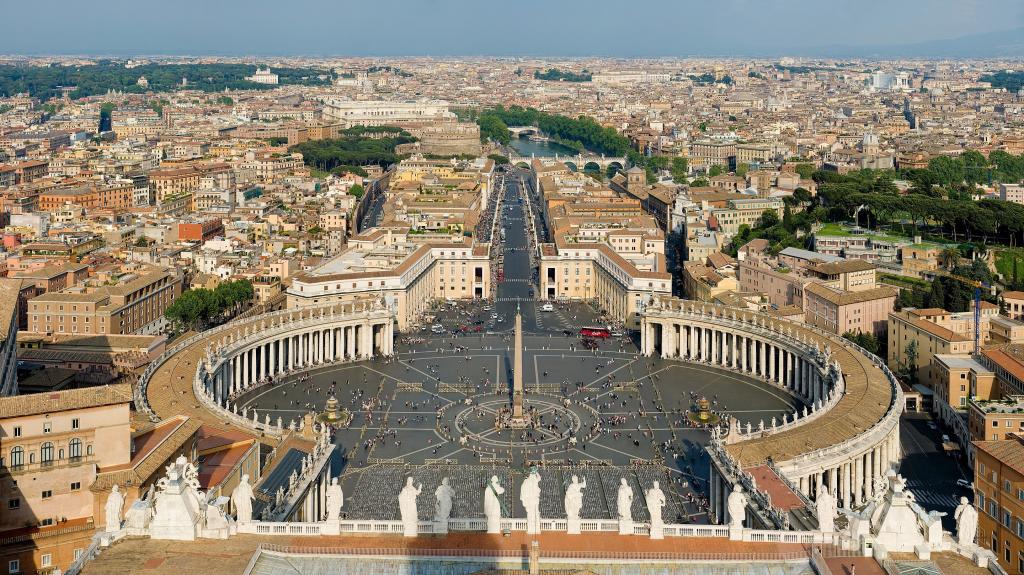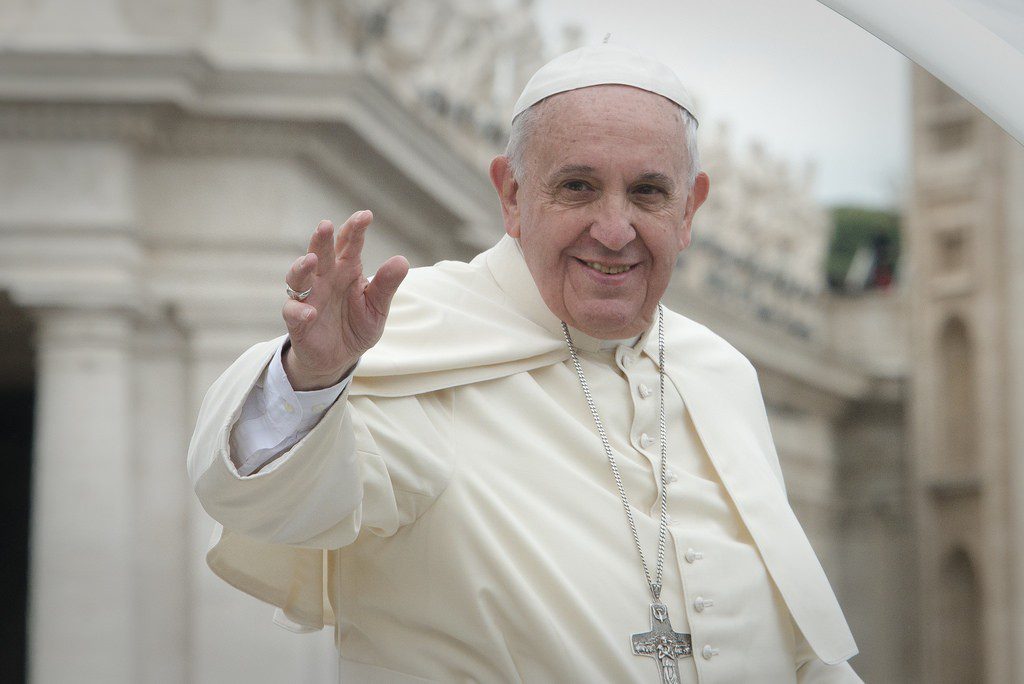
The Vatican can’t seem to make up their minds about the carved figure of a woman (actually multiple such carvings, originally purchased at a Brazilian artisan’s market) given a place of honor at various rites during the Amazon Synod.
A recent National Catholic Register article reports:
“There is nothing to know. It is an indigenous woman who represents life,” said Father Giacomo Costa, part of the synod communications teams. “It is a feminine figure [which] is neither pagan nor sacred.” . . .
Paolo Ruffini, the prefect of Vatican communications dicastery, said that he sees the figure as “representing life,” which is basically saying that it is a fertility (life) symbol, in different words.
The Catholic press bent over backwards to offer various accounts of something apparently so mysterious that it could not be straightforwardly explained by the people who thought it important enough to bring it across the oceans. The secular press was not so accommodating, and said flat-out that it was an “indigenous fertility symbol,” in the words of The Associated Press.
When said carvings were removed from the church in which they were displayed and thrown into the Tiber by anonymous men who posted their video on YouTube, there was cheering by traditionalists but anger by the activist group REPAM, who accused traditionalists of “religious intolerance” and “racism” and a “refusal to build new paths for the renewal of our church.”
And in today’s news, the pope himself apologized for the act.
“As bishop of this diocese,” Pope Francis, who is Bishop of Rome, said, “I ask forgiveness from those who have been offended by this gesture.”
Pope Francis also reported that the statues had been recovered from the river, are not damaged, and are being kept in the offices of the head of Italy’s national police. . . .
According to the transcript provided by the Vatican, the pope referred to the statues as “Pachamama,” the name traditionally given to an Andean fertility goddess, which can be roughly translated as “Mother Earth.”
While it is unclear whether he was using it colloquially, the pope’s use of the term “Pachamama” will likely further ongoing debate regarding the exact nature of the statutes, and what they represent.
So what are these statues meant to be? Are they being reverenced as if they were sacred? Their defenders say they “represent life” but they are being treated as more of a sacred object than if they were merely symbolic of creation, or God’s blessings, or the like, being included in a procession and in a tree-planting rite. Near as I can tell, for some of their supporters, the statues are meant to represent a sort of “Mother Earth” which comes from the sort of neo-pagan sensibility that the earth is sacred, a sort of pantheism that is altogether different than Christian belief in one God who is the creator and stands apart from creation. And some of them have such a vague understanding of what it means to be a Christian that they find it to be entirely congruent with their religious beliefs to reverence “life” or “fertility” or “Mother Earth” as a sacred thing in its own right rather than a gift from God, or they have perhaps forgotten that “religious tolerance” means accepting that people outside your religion have different beliefs, rather than one’s one religion becoming meaningless.
Here’s Dwight Longnecker:
Now here is the big difference between Catholic images and the statue they are parading around the Vatican.
It’s really very simple.
An authentic Catholic image is the representation of a real person who, by God’s grace, has become remade into Christ’s likeness. The saint has become an image of the unseen God.
A pagan image is not a real person. A pagan image is an idol. It is either a representation of a demon or it is a symbol of some sort of spirit or demigod (which is a nice name for a demon).
Even if the Amazonian female statue is nothing more than a symbol, we don’t venerate symbols. We have symbols in church. The Chi-Rho is a symbol. The triangle in three circles is a symbol. The Lamb of God is a symbol, but we don’t venerate symbols. We don’t carry them around in processions. We don’t light candles in front of symbols. We don’t put symbols in the middle of prayer circles and bow down before them.
And, to revisit the original National Catholic Register article, well, its title says it all:
Elementary Pastoral Sense Absent From Amazonian Statue Controversy
Since symbols convey so much more than words, Vatican officials should have clarified exactly what the statue means, before allowing it to be deployed in a paraliturgical context.
And the author explains that even in the circumstance in which this was all a misunderstanding and the statue was simply a symbol of the Amazon, a mere decoration, it was inappropriate to have been treated as it was, placed in a side chapel, and in any case the various Vatican officials had an obligation to avoid any confusion, any appearance of idol worship.
Which is pretty much where I’m at. There are plenty of instances of symbols of the community being used in some such settings — I will say based on vague memories that a medieval religious processions would have various guild members carrying symbols of their trades, and a side altar funded by a goldsmith’s guild, for example, might have symbols of that profession. But they were never shown any special reverence. And at the same time, I almost have the feeling the Vatican is being cagey about its meaning because they think some of the people of the Amazon do believe it is a “Mother Earth” symbol, and this doesn’t really both them.
Who are the Viri Probati?
The synod participants, in addition to yammering about the environment, spent a great deal of attention on the question of ordaining viri probati, that is, older married men within a community which is so remote as to otherwise not have regular masses celebrated, only occasionally when a visiting priest arrives.
Here’s are a few excerpts from a First Things article on the topic:
Over the last five years, Pope Francis has empowered Bishop Erwin Kräutler and his allies, who urge the Church to abandon its general insistence on priestly celibacy. In 2014, Kräutler discussed his ideas with the pope. In 2015, the pope asked him to make “bold, daring proposals” for the Amazon region, and two years later Francis appointed Kräutler to the committee organizing the Amazon synod. Kräutler has related how, last year, he and his allies campaigned successfully for their married-priests idea to be on the synod agenda; now it is thought to be part of the synod’s draft final document, which will be voted on tomorrow. . . .
He frequently refers to the work of another bishop, Fritz Lobinger, who has written at length on ordaining married men. In Lobinger’s dream set of reforms, the priesthood as we know it will be pushed to the margins: Instead, married “elders”—perhaps, dear reader, you and I—will be trained part-time to take up our sacramental duties. We “elders” will still wear ordinary garb and do ordinary jobs, but we’ll also say Mass, hear confessions, and so on.
Eventually, Lobinger writes, there will be communities where “elders” outnumber the old-school priests by a ratio of 30 to 1, or 15 to 1, and Catholics may be able to “overcome the stage where they prefer” the old system.
And this is what bugs me more than the question of married priests per se: the idea that the priesthood would be reduced to the role of sacrament-doers.
I have gotten no sense from any of what I have read that these married church-elder priests would be expected to undertake significant theological training. To be a priest, it appears, would become a matter simply of having had the ordination rite performed to empower one to say mass, and perform the sacraments of reconciliation and anointing of the sick. Knowing the teachings of the church, understanding scripture, the whole lot, becomes optional.
Now, I should say that I also have no sense of whether this is part and parcel of an expectation that indigenous folk are too uneducated for theology to matter to them, or, more general, any knowledge of church doctrine beyond instruction in the 7 sacraments, say, and that what matters more is for them to follow their particular customs and traditions. It also promotes a sense that they are and will always be dependent on their “betters” of none of them can ever become learned and have to make do with training in performing rituals. And this doesn’t sit right with me.
And what about female deacons?
Here’s an article in the America magazine of the Jesuits: “As the Amazon Synod nears the end, a Brazilian bishop makes the case for women deacons.”
On the eve of the highly anticipated voting on the final document of the Synod of Bishops for the Pan-Amazonian Region, Bishop Evaristo Pascoal Spengler, O.F.M., of Marajó, Brazil, chose to focus his remarks at the daily Vatican press briefing on Oct. 25 on the synod’s discernment of an “official ministry” for women. . . .
At the briefing, Bishop Spengler, 60, a native Brazilian, described the “decisive presence of women” in the history of salvation, as prophets, judges, the mother of God, saints, papal counselors and doctors of the church. And, he added, “St. Paul speaks of women deacons serving the community.”
“If we look to the Amazon today,” he continued, “over 60 percent of communities are coordinated and led by women.” Women are the majority of catechists, ministers of the Word and of the Eucharist, “so women have a decisive presence in the Amazon,” he said. . . .
Inés Azucena Zambrano Jara, M.M.I., of Colombia, also fielded a question on the topic. A journalist asked the sister, who is an auditor at the synod, what difference it would make for women and their ministry in Amazonia if the pope approved a proposal for women deacons.
“This would confirm our identities, our baptismal nature,” she responded, adding that her congregation, the Missionary Sisters of Mary Immaculate and of St. Catherine of Siena, “walks together with indigenous people and has been doing so for 100 years.”“We want to enhance indigenous women,” she said. “This is what we are fighting for.”
And this is what I notice:
The sister says the ability to be ordained to the diaconate would “confirm our identities, our baptismal nature” — which is a very odd thing to say, when this prospective ordination has nothing to do with baptism, as, of course, every Catholic is baptized and only a small number are ordained. The institution of a female version of the diaconate, whether it simply means inviting women into the category of “permanent deacon” alongside men or creating an entirely new pathway for “female deacons,” is a form of clericalism. I am not seeing any explanation of why a female diaconate is important to enhance the ministry of women in the church, now being undertaken as laywomen. I am not seeing something like “in misogynist parts of the Amazon, women are not being accorded the respect they would have if we called them deacons.” I am not seeing, “if we called women ‘clergy,’ they would be protected from persecution.
As best as I can tell, this is really a matter of “credentialing” women and granting them official status and recognition. And maybe either or both of these are worthy things: to say, for instance, that so-and-so is certified as sufficiently educated in church teaching to be able to instruct others, or to be able to bestow on a woman a title of honor for the work she does in her local church community. Maybe that’s really what it means to be a deacon, given that a (male) deacon has no special sacramental powers (he can “do” baptisms, but so can any baptized Christian), and maybe that means that it’s an entirely reasonable action to ordain women, as a form of commissioning to ministry, a formal recognition, the bestowing of a title, and a credentialing of qualification for ministry. But I wish we would talk about it in those terms rather than as a sort of consolation prize for not having the ability to be ordained priests.
Anyway, I’ve rambled a lot. Readers, what do you think?










